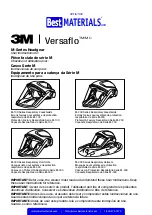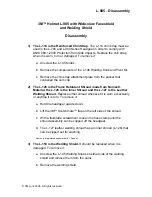
BLIND INTERSECTIONS
If you appr
oach a blind intersection, move to the portion of the lane that will bring you into another driver’s field of vision at the earliest possi-
ble moment. In this picture, the rider has moved to the left portion of the lane—away from the parked car—so the driver on the cross street can
see him as soon as possible.
Remember, the key is to see as much as possible and remain visible to others while protecting your space.
If you have a stop sign or stop line, stop there first. Then edge forward and stop again, just short of where the cross-traffic lane meets your lane.
From that position, lean your body forward and look around buildings, parked cars or bushes to see if anything is coming. Just make sure your
front wheel stays out of the cross lane of tra
vel while you’re looking.
PASSING PARKED CARS
When passing parked cars, stay toward the left of your lane. You
can avoid problems caused by doors opening, drivers getting out of
cars or people stepping from between cars. If oncoming traffic is
present, it is usually best to remain in the center-lane position to
maximize your space cushion.
A bigger problem can occur if the driver pulls away from the curb
without checking for traffic behind. Even if he does look, he may
fail to see you.
In either event, the driver might cut into your path. Slow down or
change lanes to make room for someone cutting in.
Cars making a sudden U-turn are the most dangerous. They may
cut you off entirely, blocking the whole roadway and leaving you
with no place to go. Since you can’t tell what a driver will do,
slow down and get the driver’s attention. Sound your horn and
continue with caution.
PARKING AT THE ROADSIDE
Park at a 90° angle to the curb with your rear wheel touching the curb.
INCREASING CONSPICUITY
In cras
hes with motorcyclists, drivers often say that they never saw the motorcycle. From ahead or behind, a motorcycle’s outline is much small-
er than a car’s. Also, it’s hard to see something you are not looking for, and most drivers are not looking for motorcycles. More likely, they are
looking
through
the skinny, two-wheeled silhouette in search of cars that may pose a problem to them.
Even if a driver does see you coming, you aren’t necessarily safe. Smaller vehicles appear farther away and seem to be traveling slower than they
actually are. It is common for drivers to pull out in front of motorcyclists, thinking they have plenty of time. Too often, they are wrong.
However,
you can do many things to make it easier for others to recognize you and your cycle.
CLOTHING
Most crashes occur in broad daylight. Wear bright-colored clothing to increase your
chances of being seen. Remember, your body is half of the visible surface area of the
rider/motorcycle unit.
Bright orange, red, yellow or green jackets or vests are your best bets for being seen.
Your helmet can do more than protect you in a crash. Brightly colored helmets can also
help others see you.
Any bright color is better than drab or dark colors. Reflective, bright-colored clothing
(helmet and jacket or vest) is best.
Reflective material on a vest and on the sides of the helmet will help drivers coming from the side to spot you. Reflective material can also be a
big help for drivers coming toward you or from behind.
15
6
Test Yourself
Making eye contact with other drivers:
A. Is a good sign they see you.
B. Is not worth the effort it takes.
C. Doesn’t mean that the other driver will yield.
D. Guarantees that the other driver will yield to
you.
Answer - page 25
STOP SIGNS
BLIND INTERSECTIONS
PARKING AT CURBS
PARKED CARS
Summary of Contents for HSMV 71905
Page 26: ...26...













































